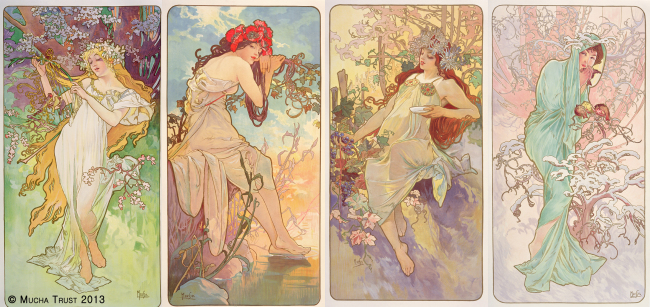The lavish and decorative paintings of Alphonse Mucha, the master of Art Nouveau, are on exhibit in Seoul for the first time, shedding light on the first era of modern art and its development in the late 19th century.
The “Alphonse Mucha: Art Nouveau and Utopia” exhibition at Seoul Arts Center introduces 235 works of Mucha, one of the most celebrated artists in the Czech Republic, which are leading examples of the Art Nouveau style.
“Mucha is regarded as an artist known for his decorative poster designs, but the exhibition shows the life of Mucha and the comprehensive collection of his works in chronological order,” said Choi Anna, curator of the exhibition, during the press conference on Wednesday.
The exhibition features posters, paintings, drawings, photographs and jewelry by Mucha on loan from the Mucha Foundation. The foundation has held exhibitions around the world including Japan where more than 70 exhibitions have been held.
 |
“The Seasons: Spring, Summer, Autumn, Winter,” 1896, color lithograph, by Alphonse Mucha. (Mucha Foundation/Seoul Arts Center) |
“The collection is the largest and the most comprehensive collection of Mucha in terms of the more than 3,000 works we have. The objective of the foundation is to make the works available to the audience,” said John Mucha, grandson of Alphonse Mucha and head of the Mucha Foundation.
Art Nouveau, or “new art” in French, prevailed from 1890 to 1910 throughout Europe where it was adopted by architects, furniture makers, jewelers and graphic artists featuring lavish decorative lines and patterns. Amid the new trend, artists such as Gustav Klimt, Louis Comfort Tiffany and Alphonse Mucha sought their own styles of art Nouveau.
Mucha’s style was one of the most sought-after styles across Europe, producing many copied designs.
The exhibition, divided into six sections that shed light on key periods of Mucha’s career, starts with his Paris years. Several interesting photos of him taken with Paul Gauguin are worth looking at. A photograph shows Mucha and Gauguin, Gauguin’s mistress Annah and Czech painter Ludek Marold altogether.
Mucha rose to instant fame by making a poster for “Gismonda,” a play featuring star actress Sarah Bernhardt staged in Paris. He portrayed her as an exotic Byzantine woman wearing a glamorous gown and head piece. The arched background, flowery design on the edges, romantic gowns and the flowing hair of the woman became the distinctive hallmark of his paintings and other illustrative works.
His poster designs earned him the title of master of poster art, which popularized art as something people hang at homes.
Some of the highlights of the exhibition are decorative panels ― posters without text ― made for display, which appealed to the wider public during Mucha’s time. Thanks to the progress in printing technology, Mucha’s panels were produced in large numbers, some of them including “The Seasons,” “The Flowers,” and “The Times of the Day.”
Other highlights include “The Slav Epic,” Mucha’s tribute to his home country and people. Fulfilling his longtime wish to work for his country, Mucha depicted the history of the Slavic people, wishing for the independence of his country. In celebration of the 10th anniversary of Czechoslovakia’s independence, he presented the completed work to the city of Prague.
The exhibition runs through Sept. 22 on the third floor of the Hangaram Art and Design Museum at Seoul Arts Center, Seocho-dong, Seoul.
Admission is 12,000 won for adults, 10,000 won for teenagers and 8,000 won for children. For more information, visit 222.mucha2013.com, or call 1666-2775.
By Lee Woo-young (
wylee@heraldcorp.com)








